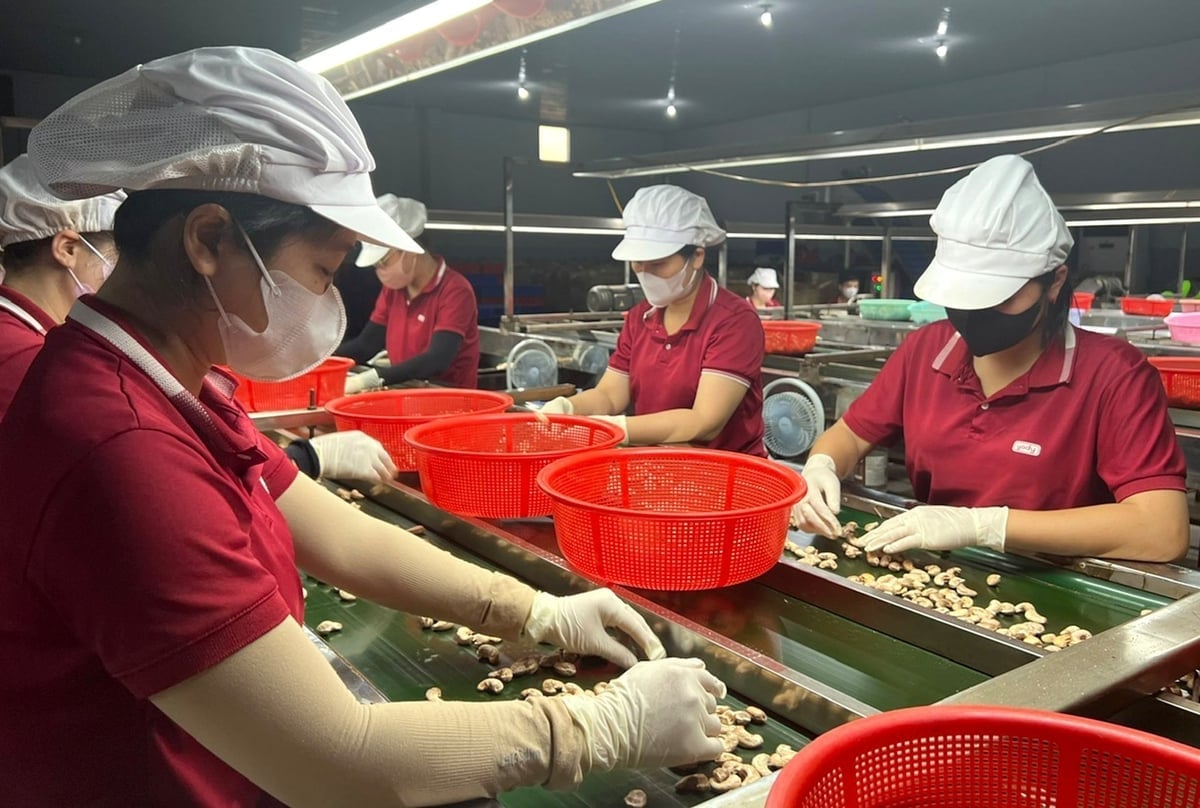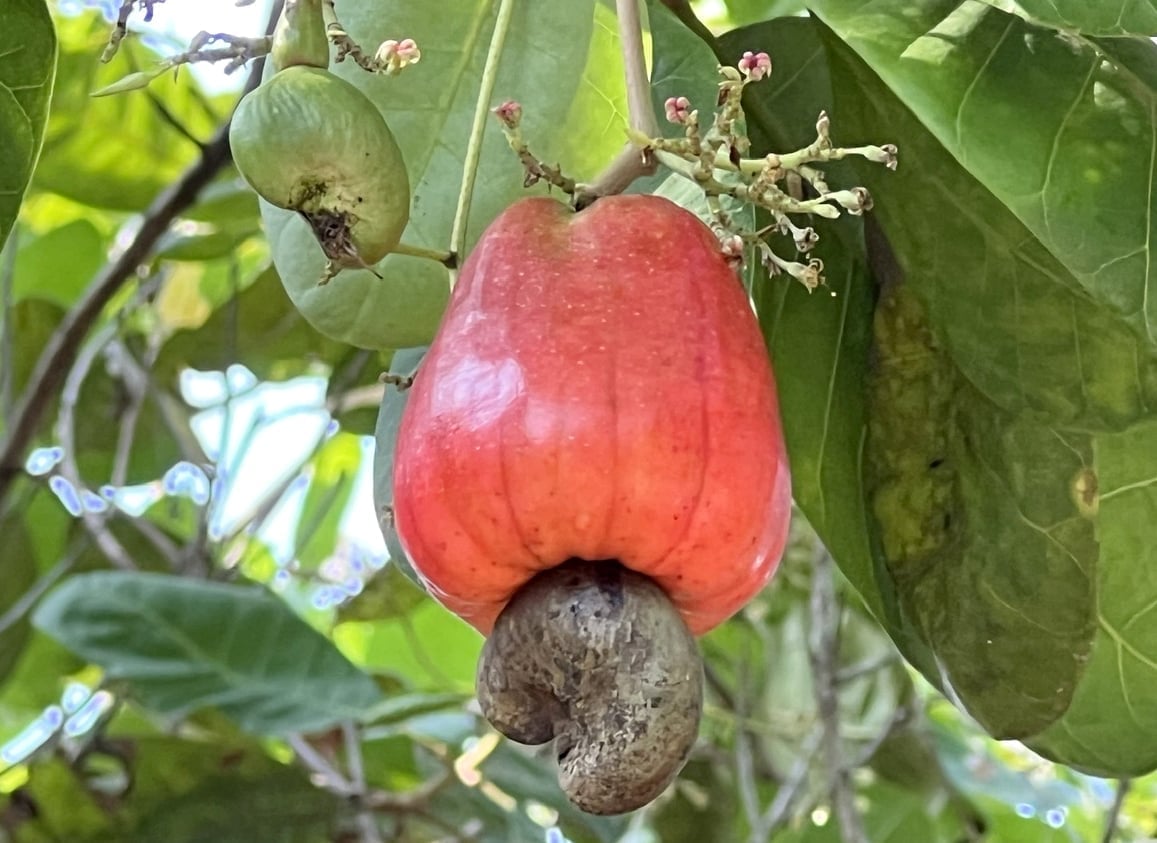November 21, 2025 | 17:16 GMT +7
November 21, 2025 | 17:16 GMT +7
Hotline: 0913.378.918
November 21, 2025 | 17:16 GMT +7
Hotline: 0913.378.918

Processing cashew nuts for export at Hoang Son 1 Joint Stock Company. Photo: Thanh Son.
Vietnam’s cashew nut exports have recorded growth for the fourth consecutive month, reaching 68,000 tons in July, valued at USD 460 million, up 1.3% in volume and 11% in value compared to the same period in 2024. As a result, cashew nut export turnover by the end of July hit USD 2.8 billion, up more than 18% year-on-year, while export volume decreased by 2.6% (reaching 413,000 tons).
The sharp rise in cashew nut export prices has contributed to impressive turnover growth over the past seven months. On average, cashew nut export prices in the first seven months of the year reached USD 6,805 per ton, nearly 22% higher than in the same period of 2024.
One noteworthy point is that China has surpassed the United States in becoming the largest market for Vietnamese cashew nuts, as exports to this market surged in both volume and value. In the first seven months of the year, cashew nut exports to China reached 96,000 tons (up 29%) and USD 608 million (up 47%) compared to the same period in 2024.
According to Mr. Bach Khanh Nhut, Vice Chairman of the Vietnam Cashew Association (VINACAS), exports of cashew nuts to China have risen sharply over the past one to two months as Chinese traders prepare food supplies for the upcoming Mid-Autumn Festival.
Meanwhile, the Import and Export Department under the Ministry of Industry and Trade assessed that exports of cashew nuts to China have increased since the beginning of the year due to China’s economic recovery, growing demand for healthy agricultural products, and Vietnamese enterprises' ability to better meet Chinese partners’ requirements.
In contrast with China, exports of cashew nuts to the United States have dropped significantly. In the first seven months of this year, cashew nut exports to the United States reached 83,000 tons and USD 561 million, down nearly 28% in volume and almost 12% in value compared to the same period last year.
Explaining this, Mr. Nhut said that since April 2025, after the U.S. government announced plans to impose retaliatory tariffs on trade partners, many U.S. importers have temporarily suspended cashew purchases out of concern that shipments arriving when the tariffs take effect could be subject to uncertain rates. This sentiment has significantly affected Vietnam’s cashew nut exports to the United States in recent months.

China will be the largest export market for cashew nuts this year. Photo: Thanh Son.
Statistics from the United States International Trade Commission show that in the first half of 2025, the United States imported nearly 90,000 tons of cashew nuts worth USD 628 million, down 9.3% in volume but up 12.8% in value compared to the same period in 2024. In the first half of this year, the United States increased imports of cashew nuts from Côte d'Ivoire and Brazil while reducing purchases from other markets, including Vietnam, the largest supplier.
Specifically, in the first six months of the year, cashew nuts imported from Vietnam into the United States totaled 79,000 tons worth USD 547 million, down 10% in volume but up more than 13% in value compared to the same period in 2024, thanks to higher prices (averaging USD 6,941 per ton, up 26%).
Following the official announcement of retaliatory tariffs, Vietnamese cashew nuts have faced disadvantages in the U.S. market, as their prices have already risen significantly compared to last year. With an additional 20% tariff, prices have climbed even higher. When cashew prices become too high, consumers tend to reduce cashew consumption and shift to other nuts widely produced in the United States, such as almonds, walnuts, and pistachios.
Furthermore, among the countries exporting cashew nuts to the U.S. market, Côte d'Ivoire enjoys a more favorable retaliatory tariff rate than Vietnam, at 15%. With a 5% tax gap and shorter geographical distance than Vietnam, U.S. importers may prioritize cashew imports from Côte d'Ivoire before considering Vietnam.
For more than a decade, the United States has been the largest market for Vietnamese cashew nuts, often accounting for over 20% of export volume (in 2024, the United States accounted for nearly 27%). Therefore, the difficulties caused by retaliatory tariffs will have a considerable impact on cashew nut exports to this market.
In this context, exporting processed cashew nuts has become an important solution for Vietnam’s cashew industry. While U.S. traders have reduced imports of cashew kernels, they have increased purchases of processed cashew products. In the first six months of this year, the United States imported nearly 28,000 tons of processed cashew nuts worth USD 214 million, up 33% in volume and 53% in value compared to the same period in 2024.
The increase in U.S. imports of processed cashew nuts is a noteworthy trend, reflecting a shift in consumer behavior toward ready-to-eat products. Vietnam, India, Thailand, and Canada are the leading suppliers of this product category to the United States, with Vietnam’s processed cashew exports rising.
China will remain the most important destination for Vietnamese cashew nuts in the remaining months of the year as demand continues to grow. VINACAS leaders believe that China will be the largest market for Vietnamese cashew nuts throughout the year.
Translated by Huong Giang

(VAN) A surge in Ukrainian egg exports, largely driven by soaring sales to the UK over the last few years, has notably pushed up egg prices on the domestic market.

(VAN) The price of Arabica Catimor coffee in Quang Tri is currently at VND 25,000–27,000/kg (fresh cherries), the highest level ever recorded

(VAN) 'From the coffee story, we can think deeper and further about the crop production sector - from development orientations and value-chain organization to international integration,' assessed Dr Le Quoc Doanh.
/2025/11/18/2431-0-161627_248.jpg)
(VAN) Viet Nam accounts for 43% of the world's export volume of Robusta coffee. However, the Vietnamese Robusta coffee brand has yet to gain broad recognition on the global market.
/2025/11/18/5617-2-125215_406.jpg)
(VAN) The consumption demand for premium, healthy, and cold-brew tea products is rising globally, including in the Thai market, opening new opportunities for Viet Nam.

(VAN) The 3F+ model aims for selective resource management, regenerative protection, green education and consumption, all intrinsic to Dabaco’s sustainable development strategy.

(VAN) Carefully packed tea bags, neatly arranged inside containers, begin their 5,000-kilometer journey to Afghanistan, carrying with them the aroma of mountain forests and the pride of Lai Chau province.